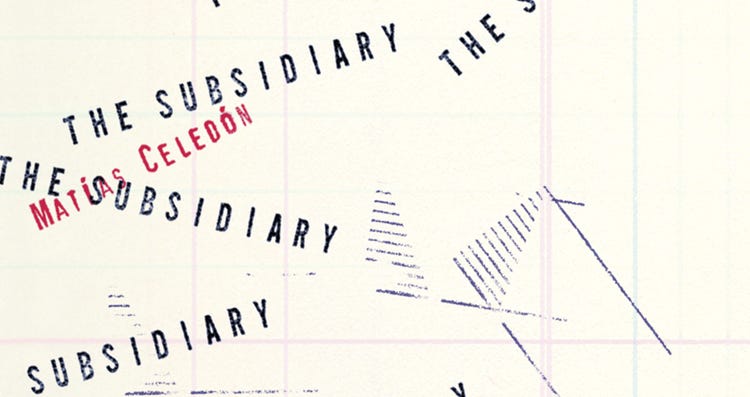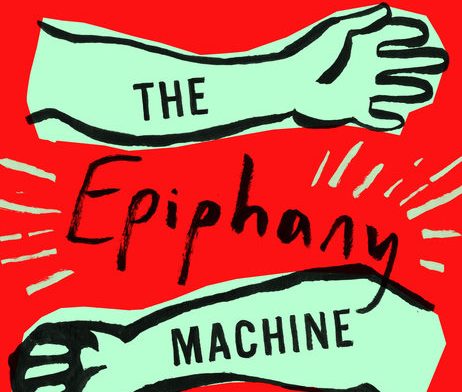Books & Culture
First they Came for the Office Workers, and I Wrote Poetry
First They Came for the Office Workers, and I Wrote Poetry In Celedón’s The Subsidiary, the medium becomes the centerpiece of the message

The first and last pages of Matías Celedón’s The Subsidiary appear to be images of the top and bottom of a stamp pad. Between these pages are the ink impressions of an anonymous narrator, an office worker documenting in rubber-stamped snippets his experience during an unnamed crisis.
My medium is decidedly less interesting, but if I’m not careful, I’ll quickly exceed the source material’s low word count.
The book offers no backstory or setup. Personnel — of precisely what entity, we don’t know — are notified to remain at their workstations in advance of a power loss. Exits are soon blocked, phone lines cut, and shouts pour in from outside. The employees are left alone. The reader and characters remain equally clueless, but while the latter appear uninterested in an explanation, I, for one, actually wondered what might be going on.
The narrator, trapped in the offices, documents the situation’s steady decline via his only available tools — the very rubber stamps he uses to approve possibly nefarious directives within a sinister corporate bureaucracy. His testimony is the story.
Allow me to say up front: I’m not gimmick-averse, and I’m always a sucker for workplace satire or commentary on draconian office politics. Locked in cubicles beneath harsh fluorescent lights, drudging along, our animal instincts threatening to boil over at the slightest hint of a rupture in the societal order — please, do tell. Replace decorum with bloodthirsty, survival instincts, and I’m happy.
And yet, there is both more and less to this story. More, in that considering the author’s Chilean heritage, one can’t help but read it in light of the often brutal history of 20th century Latin America, with its timeline of assassinations, death squads, coups, protestors violently squelched, dissidents quietly disappeared.
In The Subsidiary, there are commands issued from above. There are attack dogs. Bodies are quietly removed. The methods are all there. The book reads like poetry or a series of cryptic koans, each page usually only a single sentence or even a single word. Considering the nature of its composition, this makes sense.

The medium is the message, and the effort in composing a message via rubber stamps requires patience, deliberation, and economy. To give you an idea, rubber stamp sets actually come with a pair of tweezers to select and place the tiny characters. The sparse writing is certainly consistent with concept.
Sure, Celedon’s self-imposed limitation could be labeled a device, but I find it a wonderful premise.
If this was an actual, historical document, I would marvel at its existence.
The book could be an artifact from a group of people who’ve gone missing, or have been disappeared. If uncovered from a mass grave or presented as evidence to indict a brutal, murderous dictator, it would be an amazing document. I would even clamor for its publication. That said, however fascinating an artifact, as a story or literary work, it’s ultimately unsatisfying.
Sadly, I doubt that even a third reading would soften my opinion that many of the events and characters verge on complete inscrutability. The ease with which you can dive back in and read several pages somehow makes it all the more frustrating when you close it, having gained no further insight.
This dissonance between value as artifact versus value as novel begs the question of how much to suspend my disbelief and play along, because a narrator change late in the third act confirms Celedón wants us to read it as such a document. If read as an accompaniment to a history of Pinochet or another human rights nightmare, it would certainly resonate. Sans that context, however, it’s difficult to engage with a text so purely idea-driven.
As a physical object, it does appeal to a resurgence in print versus e-books. Publishers Weekly and the Codex Group recently cited a possible “digital fatigue” among consumers, and stories with qualities unique to printed books are ripe for success. Reading The Subsidiary, I thought, this could only exist as a printed book. It is a story defined by its device. I heard Chris Ware speak during the release of his massive project, Building Stories, about sales in bookstores being boosted by graphic novels and their appeal as unique objects versus mutable variations of “content.” They are stories only able to be told in book form.
To my surprise, I discovered The Subsidiary is available for the Kindle. I can’t even imagine. What good comes from this book, what thoughts it engenders, what horrors it suggests, stem from its inherent possibility as testimony to historical tragedy or farce. To download such a thing, a missive from a dark corner of a frightened bureaucrat’s office during a political or corporate cleansing, is absurd.
Had I read the e-book, I can tell you this review would be much shorter, considering much of the discussion surrounding it is and will be its storytelling device. As a piece of literature, there’s simply too little to discuss.
The handful of characters are all named after their particular physical limitation. “Blind girl,” “deaf girl,” “lame man,” “one-armed man,” “one-eyed man,” “mute girl.” What symbolism there is, or why a corporation hires only the disabled is unclear. At one point, “The mute girl moans. The one-armed man applauds.” There’s the koan-like (and in this case, groan-inducing) nature I mentioned.
At one point the Mute Girl tells the narrator that the Lame Man is holding a young boy captive and teaching him to read. “The Mute Girl went on calmly and in detail. The boy was lost. He was poor, without manners: the Lame Man had to bathe him.” There are no further details. How did this boy get into the office? How, over the course of the book’s two-week narrative, was the idea to teach a child to read something that entered the imagination? What office has a bathtub?
The ending is somewhat chilling, but having no emotional investment in characters or story, it’s hard to know how to feel. The original office worker’s record lives on, accessed by another anonymous bureaucrat. Despite briefly acknowledging the horror within, it’s clear the incident will be filed away, covered up, buried. The final image is an impression of the lines of a rubber stamp devoid of text. Only the blank stamp has been covered with ink and pressed to the page. Nothing left — or permitted — to be said.
Celedón thus maintains verisimilitude, as I’m sure similar accounts exist in international courts created by people whose names we’ll never know, who died horrible deaths in isolation. But in so doing, the story never transcends its device. It is a self-contained document that remains impenetrable.

Maybe it’s a failure of my own imagination. Maybe it says something about my lack of humanity, or maybe it’s the privilege of living a comfortable existence in the United States that prevented me from connecting with The Subsidiary. If November heralds the rise of President Trump, at least I know a third reread will take little time, and I can draw comfort from the knowledge that rubber stamp sets are very affordable.









